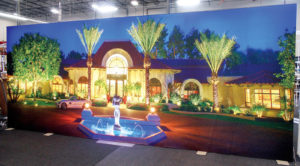
Those contemplating adding fabric graphics to their professional repertoire will find an arena poised for expansion and strong demand, driven by advancements in print and ink technology as well as by fabrics that increasingly deliver stunning results more reliably. Also fueling activity is the accelerating movement toward personalization and customization, says Randy Anderson, product marketing manager, textiles, for Mutoh America Inc.
“Virtually every single market is looking at or moving into the personalization market,” says Anderson, adding that this trend is sparking interest in dye-sublimation systems, from desktops to wide-format.
“In general, these appear to be for smaller runs and personalization in particular, with greater growth in SEG and SEG backlit for dye-sublimation, along with [ongoing] growth for clothing and sportswear,” he continues. “The interest in direct-print systems stems from the ability to personalize natural fabrics like cotton, silks, wool and blends not friendly to dye-sublimation.” (SEG stands for silicone edge graphic technology, which incorporates silicone beads around the edge of the fabric, making it easier to frame.)
Located in Phoenix, Ariz., Mutoh makes a wide range of printer solutions, including the ValueJet 1948WX, a four-head, high-speed dye-sublimation printer designed for production-based printing, such as trade show graphics, promotional items, flags and interior decor. Another offering is the ValueJet 1938TX, a 75-inch-wide direct-to-textile printer used to create customized fashion apparel, upholstery, scarves, and interior decor, along with tradeshow graphics, soft signage, flags, sportswear and other items. Both deliver fast print speeds, says Anderson.
“Speed is, of course, a concern for many, but for many more, the ability to run short runs and customize each printer outweighs concerns for speed,” he explains. “So at the top end, speed is the primary concern, but at virtually every other level, customization ability prevails.”
Designs without boundaries
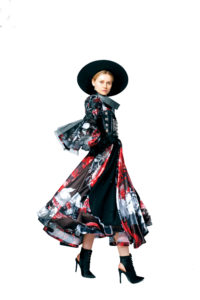
Monika Dees, senior product manager, professional imaging, Epson America Inc., says she is also seeing a greater need for flexibility when it comes to fabric printing. Based in Long Beach, Calif., Epson provides products ranging from inkjet printers and digital printing systems to 3LCD projectors, watches and industrial robots.
“Designers are looking to create one-of-a-kind designs without boundaries, featuring any number of colors, shadows, photography and personalization,” Dees says. “Also, flexibility in the production stage is important. Printers are looking for options that don’t involve screens, deliver just-in-time runs and inventory, and overall reduced water consumption.”
Two printers Dees mentions are the Epson® SureColor F9370, designed for high-speed, medium-to-large volume, dye-sublimation transfer printing; and the Monna Lisa® Evo Tre, a direct-to-fabric printer. The SureColor is used by many of Epson’s industrial customers because of its quality and speed, she says. The Monna Lisa can print on any fabric and reproduce the most complex designs with speed and reliability.
The majority of the fabric graphics demand is coming from the fashion, home decor and soft signage markets, says Dees. Although she describes demand as growing by the double digits, digitally printed fabric comprises only a small part of the textile market—meaning there’s still good opportunity, particularly in the fashion and home decor arenas.
Interior decor does represent an untapped market, agrees Mike Syverson, textile manager, North America, Durst Image Technology US LLC, a Rochester, N.Y., provider of advanced digital printing and production technologies. As he explains, the interest in custom-printed home furnishings like draperies, pillows, wall coverings, upholstery and bedding is quickening, heralding potentially robust growth in the coming years.
Demand is also coming from traditional markets, such as exhibition and retail, driven by the fact that fabric graphics can be changed more quickly, shipped less expensively and generally don’t require professional installation. As for the systems that graphics printing companies serving these segments are snapping up, dye-sublimation printers are popular, thanks to their “relative simplicity,” Syverson says; he recommends that providers consider grand-format systems—those 10 feet or larger—for their greater flexibility when printing large graphics.
Durst offers the Rhotex 325, a direct and transfer dye-sub, soft-signage system that allows for the printing of seamless graphics up to 10 feet wide (any length) and can be configured with up to eight colors. The Rhotex 500 is a five-meter dye-sub, direct-print, soft-signage system. Both are high-speed. There’s also the Alpha, which can be set up with different ink sets. Many companies using this system produce graphics for the hospitality, medical and home decor markets.
Fabric technology
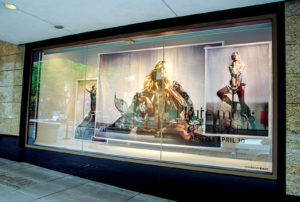
Companies working with printed fabrics are also starting to gravitate toward latex printing technology, says Kylie Schleicher, product manager for Ultraflex Systems Inc. “This technology has been evolving over the years, and the capabilities of the ink technology with fabric have continued to improve,” she says. “The technology provides vibrant colors and a soft hand—[qualities] most in demand when it comes to graphics.”
Headquartered in Riverview, Fla., Ultraflex provides digitally printable textiles and flexible substrates, with a portfolio that includes frontlit, backlit, blockout, mesh and other materials for solvent, eco-solvent, latex, UV, screen and dye-sublimation printing. Included in the inventory is the VorTex™ Backlit Event T202, a lightweight, woven polyester designed for backlit graphics and offering high resolution when printed via the dye-sub transfer process; and the VorTex Stretch D229, a polyester and spandex knitted fabric. The fabric—“More opaque than comparable stretch products,” says Schleicher—is appropriate for direct dye-sublimation, transfer, latex and UV printing.
Schleicher says the retail sector is proving especially receptive to fabric graphics, since these impart a different feel compared to traditional signage. Mike Compton, product marketing manager for Top Value Fabrics, says his company is seeing a shift toward outdoor fabrics with printed graphics. Headquartered in Carmel, Ind., Top Value serves a variety of segments, including print media textiles, vinyl, apparel and home furnishings for digital printing, as well as industrial fabrics.
“While demand for indoor fabric graphics continues a steady upward climb, so does the demand for outdoor fabric graphics,” he says. “This is due to the relative light weight compared to other substrates for cost savings in shipping and installation.”
Backlit and SEG fabrics are showing explosive growth, Compton says. Top Value recently created a backlit fabric, MicroLux 240 8169WGFS, with a proprietary coating that allows ink to dry quickly, enabling the fabric to be printed on both sides. The fabric features a knitted-in microfiber, giving it a soft feel, stable dimensional stretch and wrinkle resistance. Among other qualities, the 100 percent polyester fabric has an optic-white finish and is flame resistant and 100-percent recyclable. Applications include backlit graphics for tradeshows, retail and POP displays, among others.
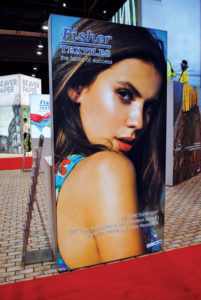
The soft signage and apparel markets continue to embrace dye-sublimation graphics, Compton says, adding that he expects digitally printable fabrics to expand in these markets as well as in home furnishings, with backlit and SEG frame fabrics juicing the growth. He suggests print service providers hone their competitive edge by entering multiple markets, establishing themselves as a single source for a variety of indoor and outdoor projects.
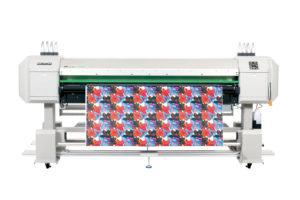
The ValueJet 1938TX direct-to-textile printer from Mutoh allows fabricators to create customized apparel, upholstery, interior decor, scarves, tradeshow graphics, soft signage, flags, sportswear and more, working print designs or photographic artwork directly onto a variety of fabrics. Photo: Mutoh America Inc.
Scott Fisher, president of Fisher Textiles, an Indiana Trails, N.C., supplier of fabrics for the digital printing industry, says indoor fabrics are experiencing the most demand. The company offers fabrics for dye sublimation, UV, latex, and direct printing to the tradeshow, retail, sports marketing, event, home furnishing, table-gaming, fine-art reproductions, and apparel markets. He attributes the popularity of indoor graphics to the SEG frames and their expansion from the tradeshow industry into retail. Two of his company’s products he mentions are the GF6090 SunBright backlit SEG fabric, popular because of its printability, soft hand and wrinkle-resistance; and the GF4019 Nirvana B.O.B.® frontlit SEG.
“This has a white face and a coated black back,” explains Fisher of the GF4019. “It offers a two-in-one solution from printable fabric with a built-in liner.”
Beaver Paper & Graphic Media Inc. has developed the SEG®, a frontlit, heavyweight, four-way stretch polyester knit fabric, says Jeff Mills, fabric product manager. Headquartered in Atlanta, Ga., the company provides dye-sublimation transfer paper, sublimation textiles and protective transfer tissue. The new fabric offers excellent opacity, has a smooth face, a soft touch and “superior print quality.” Another recent offering is the Backlit 75®, a wrinkle-proof, four-way stretch backlit fabric that eliminates pinholes. The soft hand allows for easy folding and helps eliminate cracking.
Mills says there’s been a shift in the industry; it’s less about indoor versus outdoor fabrics and more about the materials used. Traditional vinyl and paper displays are being edged out by SEG technology, he explains. At the same time dye-sublimation transfer is undergoing a renaissance propelled by advancements in transfer papers and printers. He predicts the use of dye-sublimation direct-to-print and dye-sublimation transfer will continue gaining momentum.
“There’s a noticeable increase in the use of dye-sublimation in the home goods markets as well as customizable merchandise due to the popularity of print-on-demand websites,” he explains. “Soft indoor dye-sublimation fabrics will continue to replace old signage materials in everything from tradeshow exhibits to mall storefronts.”
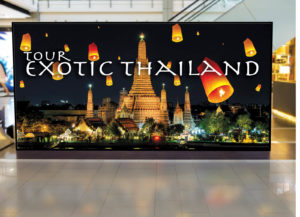
Pamela Mills-Senn is a freelance writer based in Long Beach, Calif.
Selecting the best ink for the job is as important as choosing the right printing process and fabric. Options abound, since fabrics are becoming more receptive to various types of inks and processes. For example, says Mike Compton, marketing manager for Top Value Fabrics, while most of his company’s fabrics are dye-sub printed with heat transfer inks, latex and new UV inks are growth areas Top Value is responding to, creating textile lines that are printable with these inks.
How to narrow down the field? Think about end user application, says Mike Syverson, textile manager, North America, Durst Image Technology US LLC. According to Syverson, if the final application is:
Indoor decor: wash, rub and color fastness are “very important.”
Tradeshow graphics: focus is on rub fastness and color fidelity; long-term fading usually isn’t a concern. “They’re typically indoors and changed out frequently, as is retail,” Syverson explains. “Dye-sub is ideal for these applications.”
Decor: pigmented inks are often better because of their longer color-fastness compared to dye-sub inks, and the fabric range is wider.
Thinking about making a move into fabric graphics? We asked sources for their best advice:
Start with dye-sublimation. It’s a straightforward process with low startup costs and learning curve. Find the right partner. Go to industry shows, talk to manufacturers, tour their facilities and see current customers in real production environments.
Monika Dees, senior product manager, professional imaging, Epson America Inc.
Understand the market you’re interested in supporting. The needs of a company producing soft signage or overhead fabric graphics for tradeshows and retail are different from the company wishing to provide printed fabric for commercial or residential decor. This is a great discussion to have with vendors so you can understand the solutions and find the best fit.
Mike Syverson, textile manager, North America, Durst Image Technology US LLC
Know your business model and where you want to start, including your target markets, cost, features and durability of all your system components from printers to inks, software and finishing equipment. Work with a print media supplier knowledgeable in all aspects of printing on fabric; your supplier should be able to walk you through the entire process, advising you as well as working side by side offering best practices for printing their fabrics.
Mike Compton, product marketing manager, Top Value Fabrics
Before purchasing printing equipment, also look at the equipment needed to finish a textile. This may be different than what is currently in your shop and will save unexpected costs in the long run. Purchase the right equipment for printing fabric. Don’t buy something that prints some but not all (due to stretch, translucency, etc.). The more flexibility you have when it comes to choosing a fabric, the better.
Scott Fisher, president, Fisher Textiles
Printer and ink technologies have made great strides in recent years, but that doesn’t keep manufacturers from wishing for more. Mike Syverson, textile manager, North America, Durst Image Technology US LLC, based in Rochester, N.Y., observes that as more traditional applications move to digital, printers will have to develop faster, but still cost-effective, systems.
Jeff Mills, fabric product manager for Atlanta, Ga.-based Beaver Paper & Graphic Media Inc., looks forward to any new technology—transfer paper with faster release, inks and printers—that can accelerate the dye-sublimation process. Mike Compton, marketing manager for Top Value Fabrics in Carmel, Ind., says there’s a “great desire” in the industry for ongoing development of printers, printheads and inks.
“With the majority of fabrics printed worldwide still being screen-printed with pigment inks on cotton, the market is wide open for digital printing on a variety of fabrics,” he says. “Developing a print system with printheads and high-quality pigment inks offering excellent color and binding properly to fabrics is, and will be, a game-changer.”
 TEXTILES.ORG
TEXTILES.ORG


